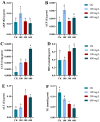Transcriptome Analysis Reveals Immune and Antioxidant Defense Mechanisms in the Eriocheir japonica sinensis after Exposure to Ammonia
- PMID: 39457912
- PMCID: PMC11503868
- DOI: 10.3390/ani14202981
Transcriptome Analysis Reveals Immune and Antioxidant Defense Mechanisms in the Eriocheir japonica sinensis after Exposure to Ammonia
Abstract
As a key species in freshwater aquaculture, Eriocheir japonica sinensis was subjected to ammonia stress to assess its impact on the hepatopancreas. A total of 4007 differentially expressed genes (DEGs) were identified between control and treatment groups, comprising 1838 upregulated and 2169 downregulated genes. Following exposure to 300 mg/L of ammonia, the oxidative phosphorylation pathway was activated, while the lysosomal pathway was suppressed, thereby influencing immune functions. Thirteen DEGs from these pathways were further validated via qRT-PCR, revealing gene expression changes of one- to two-fold. Both acid phosphatase (ACP) and alkaline phosphatase (AKP) levels in the hepatopancreas and hemolymph initially increased and then decreased, indicating a disruption in immune functionality. Additionally, alanine transaminase (ALT) and triglyceride (TG) levels were measured, alongside catalase (CAT) activity, total antioxidant capacity (T-AOC), and malondialdehyde (MDA) content, all of which showed an upward trend, signifying oxidative stress and tissue damage. These results offer critical insights into the antioxidant and immune mechanisms of E. j. sinensis in ammonia-enriched environments.
Keywords: Eriocheir japonica sinensis; ammonia; gene expression; immune response; lysosomal pathway.
Conflict of interest statement
The authors declare that they have no conflicts of interest.
Figures









Similar articles
-
Effects of saline-alkali stress on the tissue structure, antioxidation, immunocompetence and metabolomics of Eriocheir sinensis.Sci Total Environ. 2023 May 1;871:162109. doi: 10.1016/j.scitotenv.2023.162109. Epub 2023 Feb 11. Sci Total Environ. 2023. PMID: 36775159
-
Integration of metabolomics and transcriptomics reveals the toxicological mechanism of deltamethrin exposure in Chinese mitten crab Eriocheir sinensis.Sci Total Environ. 2024 Dec 10;955:176975. doi: 10.1016/j.scitotenv.2024.176975. Epub 2024 Oct 29. Sci Total Environ. 2024. PMID: 39454792
-
Effect of infection with Aeromonas hydrophila on antioxidant capacity, inflammation response, and apoptosis proteins in Chinese mitten crab (Eriocheir sinensis).Comp Biochem Physiol C Toxicol Pharmacol. 2022 Feb;252:109220. doi: 10.1016/j.cbpc.2021.109220. Epub 2021 Oct 28. Comp Biochem Physiol C Toxicol Pharmacol. 2022. PMID: 34718187
-
Effects of prometryn on oxidative stress, immune response and apoptosis in the hepatopancreas of Eriocheir sinensis (Crustacea: Decapoda).Ecotoxicol Environ Saf. 2023 Jun 23;262:115159. doi: 10.1016/j.ecoenv.2023.115159. Online ahead of print. Ecotoxicol Environ Saf. 2023. PMID: 37356403
-
The effects of ammonia-N stress on immune parameters, antioxidant capacity, digestive function, and intestinal microflora of Chinese mitten crab, Eriocheir sinensis, and the protective effect of dietary supplement of melatonin.Comp Biochem Physiol C Toxicol Pharmacol. 2021 Dec;250:109127. doi: 10.1016/j.cbpc.2021.109127. Epub 2021 Jul 9. Comp Biochem Physiol C Toxicol Pharmacol. 2021. PMID: 34252579
Cited by
-
Insights into Lead Toxicity and Detoxification Mechanisms in the Silkworm, Bombyx mori.Insects. 2025 Jul 7;16(7):699. doi: 10.3390/insects16070699. Insects. 2025. PMID: 40725329 Free PMC article.
References
-
- Liu X.H. The biological characteristics and feeding technique of Eriocheir sinensis. Hubei Agric. Sci. 2009;48:158–160.
-
- Wang X., Yao Q., Zhang D.M., Lei X.Y., Wang S., Wan J.W., Guo Z.X. Effects of acute salinity stress on osmoregulation, antioxidant capacity and physiological metabolism of female Chinese mitten crabs (Eriocheir sinensis) Aquaculture. 2022;552:737989. doi: 10.1016/j.aquaculture.2022.737989. - DOI
-
- Sui L., Zhang F., Wang X., Bossier P., Sorgeloos P., Hänfling B. Genetic diversity and population structure of the Chinese mitten crab Eriocheir sinensis in its native range. Mar. Biol. 2009;156:1573–1583. doi: 10.1007/s00227-009-1193-2. - DOI
-
- Chen D.W., Zhang M., Shrestha S. Compositional characteristics and nutritional quality of Chinese mitten crab (Eriocheir sinensis) Food Chem. 2007;103:1343–1349. doi: 10.1016/j.foodchem.2006.10.047. - DOI
Grants and funding
LinkOut - more resources
Full Text Sources
Research Materials
Miscellaneous

